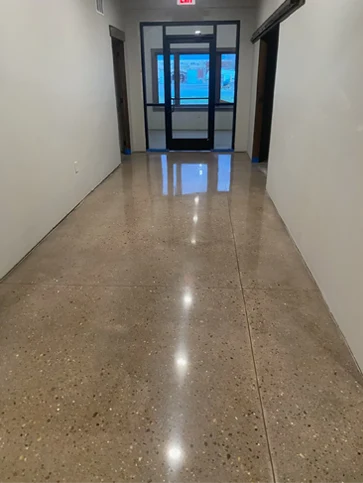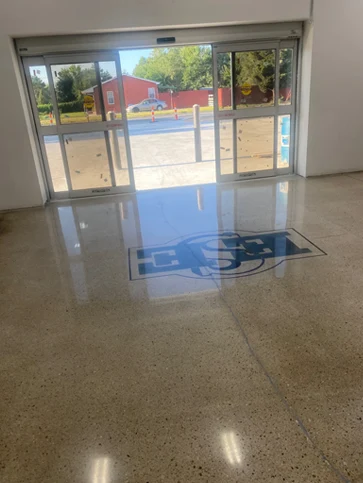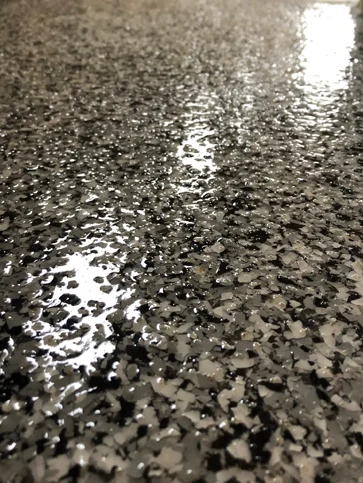What is the process for concrete polishing?
Polishing concrete floors requires extensive preparation and specialized application techniques. In general, the process involves the following steps:
- Before starting a concrete project, experts should first inspect the floor to determine what type of preparations will be necessary.
- Repairing cracks, stains, chips and holes is an important step in the concrete polishing process.
- Grinding floors to a perfect shine are our goal. We achieve this through many different methods. We will discuss each option with you in detail after the inspection.
- Refrain from relying on do-it-yourself kits for these sections if you want a solid and durable floor finished properly and professionally.
Why does concrete crack?
- Too much water in a concrete mixture will cause your floors to crack because the water dilutes the concrete’s strength once poured. The concrete ingredients will begin to separate, causing early cracks in your concrete.
- An excess of water in a concrete mixture will cause cracking, as the water dilutes the concrete’s strength. The ingredients separate, causing early cracks in the poured concrete.
- Too much weight causes concrete to crack prematurely. The cracks are likely to be more severe if the concrete is old or poorly maintained.
- A loss of moisture causes spiderweb cracks in concrete. These cracks, however, are not harmful to the foundation of the concrete and can be repaired easily.
Concrete is susceptible to cracking for a variety of reasons. The key is to take proper care of your concrete, and it is always best to hire a professional for any concrete work.
What are the maintenance requirements for polished concrete floors?
A polished concrete floor requires little maintenance compared to other floors, such as wood or marble. A polished concrete floor only needs occasional sweeping and mopping with soap and water to keep it looking beautiful and strong.
- Regularly dust, sweep, and mop your concrete’s surface to remove any harmful debris.
- When mopping polished concrete floors, make sure you use a mop made of soft material that will not damage the floor’s surface.
- When wet-cleaning, use non-acidic cleaners and do not contain soap to avoid dulling the shine of your polished concrete. Soapy substances will leave streaks on your concrete’s surface, making it look unclean and dulling its shine.
- Regularly use floor vacuums because they cause less wear and tear on your floors.
- Avoid deep scrubbing on any concrete area because it can damage the protective coating.
A polished concrete floor requires minimal cleaning, as it is resistant to everything life will throw at it. However, regular maintenance is still needed. For further questions or specific concerns, please get in touch with your contractor.
Can concrete polishing eliminate oil stains?
The concrete polishing process includes inspecting and fixing any issues that could be occurring with your concrete. Each floor has unique properties, and a professional must examine each one before beginning the grinding and polishing process. A contractor will help determine if any other issues need attention.
Can all concrete be polished?
When preparing a concrete floor for polishing, it is crucial to address any specific issues before beginning the process. Calling a professional to assess your situation can help determine whether your concrete can be polished.
How long can a polished concrete floor last?
Polished concrete floors can last for many years, depending on the environment. In an industrial setting, a floor might last less than 20 years; however, it may last well over 20 years in a residential location.
What are the benefits of polished concrete floors?
Polishing concrete floors requires extensive preparation and specialized application techniques. In general, the process involves the following steps:
- Resistance to damage is an essential quality for high-use areas. A polished concrete floor can provide that resistance because it repels chemicals, oil spills, and water.
- Water resistance is a unique and essential quality for concrete, as concrete is a porous substance. If you have concrete floors, you need to protect them against water damage because any water spilled onto them will seep into the pores and create mold and mildew.
- Polished concrete floors can last between 10 and 20 years, which is longer than most flooring options because they are impervious to everyday damage. In industrial settings, polished concrete is popular because even heavy machinery has trouble damaging it.
- Another reason for the popularity of polished concrete floors is their affordability. Not only are they inexpensive initially, but because they do not require expensive upkeep, including stripping and waxing, polished concrete floors can save you money in the long term.
Why should I polish my concrete?
Polishing concrete floors has many benefits, including the fact that a polished concrete floor is resistant to some of the problems that other types of floors face. For example, spills easily damage wood floors, and little maintenance is necessary. However, these things would not affect a polished concrete floor and would provide a long-term solution at an affordable price. Polished concrete offers a budget-friendly, long-term solution for residential and commercial properties.
Can you add color to a polished concrete floor?
We can add patterns and colors to polished concrete floors to improve their appearance. Contractors can advise clients on the most suitable designs and colors after inspection.
Can you polish a damaged concrete floor?
A professional concrete polishing contractor will take many steps to ensure that a newly polished floor meets the client’s expectations. The “new” floor is often simply the existing concrete that was already there, just fixed. The contractor will inspect your floor for damage and repair any areas fixed or addressed before polishing. If you have questions or concerns about the process, speak with your contractor before installation.


